NDVI stands for "Normalized Difference Vegetation Index". NRG stands for "Near-infrared / Red / Green". NDVI and NRG are both ways to visualize the amounts of infrared and other wavelengths of light reflected from vegetation. Because both these methods compare ratios of blue and red light absorbed versus green and IR light reflected, they can be used to evaluate the health of vegetation. It's a snapshot of how much photosynthesis is happening. This is helpful in assessing vegetative health or stress. (Read more here: https://www.agronomy.org/publications/jeq/articles/36/3/832) ## Do-It-Yourself These techniques for vegetation analysis were developed for satellite imagery, but at Public Lab, we've been working a lot on capturing infrared imagery using our DIY [near-infrared camera](/wiki/near-infrared-camera) setup, and combining it with visible bands to produce NDVI images such as the one above. ## What these images mean What exactly are these images we're trying to make? What do they tell us about vegetation, and why? These diagrams should help to understand what it is we're doing and why these are good ways to analyze plant life. ## The NDVI equation [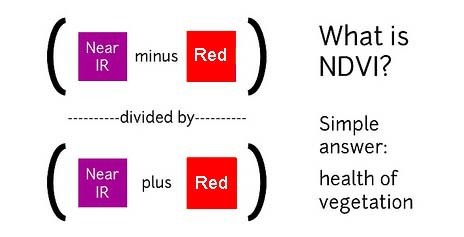](/i/44723) **NDVI = (Near Infrared - Red)/(Near Infrared + Red)** NDVI is a ratio which tries to emphasize photosynthesis while filtering out sun glare. The above equation is run for every pixel, using source data from an infrared photo and a visible light photo, like this pair: [](https://publiclab.org/system/images/photos/000/021/771/original/5390895115_c9d4d38fec_o.jpg) The result can be false-colored to make the high-photosynthesis areas more clear, and used to examine where plants are and how healthy they are. [](https://publiclab.org/system/images/photos/000/021/770/original/PetVISNDVIcomp.png) _Figure above: Normal color photo (right) and normalized difference vegetation index (NDVI) image (left). NDVI image was derived from two color channels in a single photo taken with a camera modified with a special infrared filter. Note that tree trunks, brown grass, and rocks have very low NDVI values because they are not photosynthetic. Healthy plants typically have NDVI values between 0.1 and 0.9. -- @cfastie_ ### Activities Here are a range of activities you can do to produce and interpret your own NDVI imagery, whether downloaded from a satellite imagery provider or [collected yourself using a DIY technique](/wiki/multispectral-imaging) [activities:ndvi] ****   Most DIY converted cameras today (those from Public Lab) use RGN instead of NRG, so the blue channel represents infrared instead of the red channel. That looks like this: [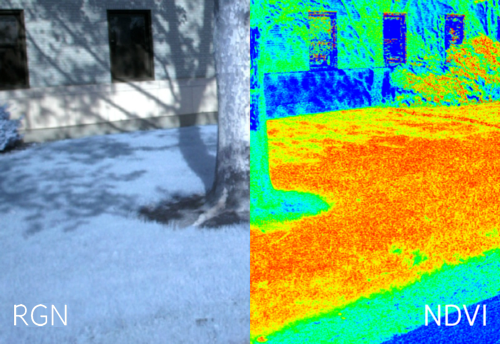](/i/45468?s=o) **** ## NRG imagery Some people are also interested in producing NRG imagery (like the below image), where `Near-Infrared, Red, and Green` are used to compose a picture instead of the usual `Red, Green, and Blue`. [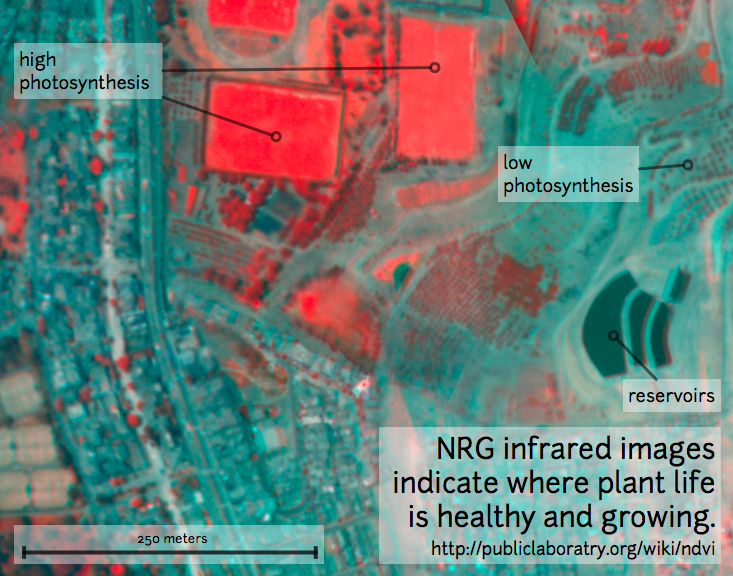](/i/25064) This diagram explains the swapping, which allows us to 'see' infrared as if it were a normal color: [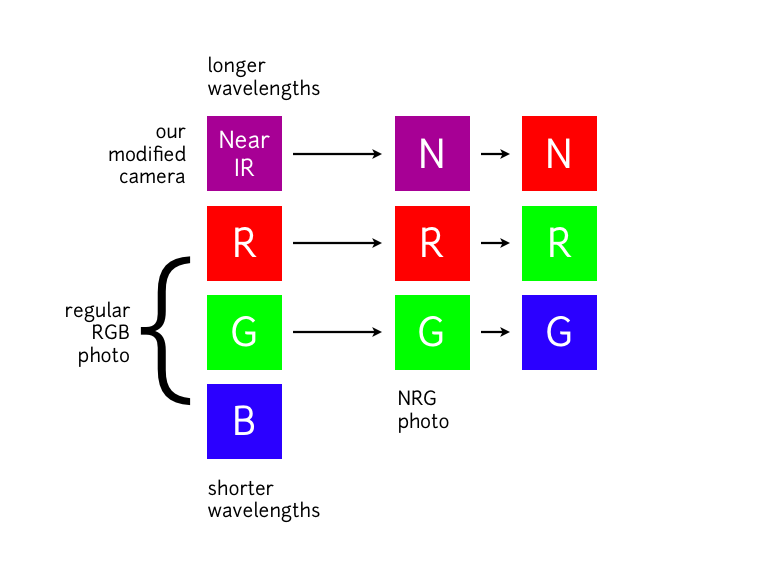](/i/25063) **In NRG images, the deeper and clearer the red color, the denser and healthier the vegetation (more or less).** ### Questions [questions:ndvi] ### Other examples of DIY NDVI imaging From around the internet: Begin watching at 2 minutes to see the resulting imagery: *This topic is part of the [Grassroots Mapping Curriculum](/wiki/mapping-curriculum) series.* **** [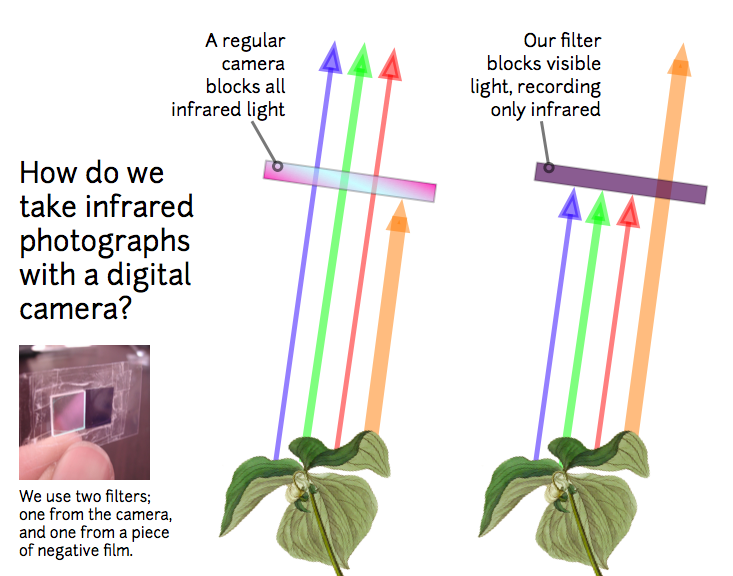](/i/25066) [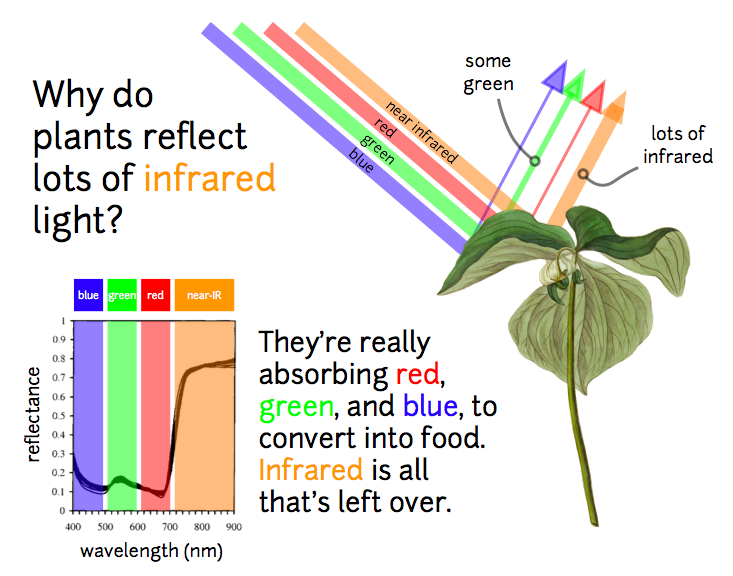](/i/25065) ...
| Author | Comment | Last activity | Moderation | ||
|---|---|---|---|---|---|
| warren | "Abdul - it looks like the config file you're using is not set up with a corrected white balance. This page has the corrected WB required as Chris ..." | Read more » | about 8 years ago | |||
| Claytonb | "@Thorsten I have not tried using a chart like the color checker though I have used materials(plastic, felt, paper) in the shade of red on the chart..." | Read more » | about 8 years ago | |||
| Thorsten | "@Claytonb great work as usual! Two questions: Have you tried some reddish colors of calibration targets such as the ColorChecker? http://xriteph..." | Read more » | about 8 years ago | |||
| cfastie | "The lamp post, the wall, and parts of the tree trunk are all very dark. It is a common artifact that NDVI computed for dark areas of photos is not ..." | Read more » | about 8 years ago | |||
| cfastie | "Abdul, You are correct that all of the things you list could be responsible for the failure to produce a meaningful NDVI image. It could also be du..." | Read more » | about 8 years ago | |||
| warren | "Or perhaps the lead image here, which uses the #19 Rosco "fire" filter currently in the Mobius Infragrams: https://publiclab.org/notes/mathew/04-30..." | Read more » | about 8 years ago | |||
| warren | "This is so great, Abdul!!! One note -- the lead image shows a blue-filtered image, whereas the Mobius uses a red-filtered sensor. So perhaps the l..." | Read more » | about 8 years ago | |||
| spandan1234 | "Hi cfastie, I need a little help here. Following your suggestions I did all the calibrations required and the results were great. But in the last f..." | Read more » | about 8 years ago | |||
| cfastie | "Even with that nice filter it won't be possible to get a pure red channel. The red channel is sensitive to NIR light, and NIR is transmitted by the..." | Read more » | about 8 years ago | |||
| aldrin | "Thank you, so much. I'm planning to use DB660/850 which is a Dual Bandpass filter for NIR and VIS. I understand that if I use it, I can Get Red+NIR..." | Read more » | about 8 years ago | |||
| Ajith_Kumar | "Thank you cfastie for the detailed description. This answer is really helpful to me. " | Read more » | about 8 years ago | |||
| warren | "Hi - would you mind making the title "How can i validate that the data I obtained using raspi noir camera are really NIR and NDVI?" so it's easier ..." | Read more » | about 8 years ago | |||
| cfastie | "This is a good question, and not an easy one to answer. Preferred characteristics of cameras to be converted to pure NIR or full spectrum (NIR + R..." | Read more » | about 8 years ago | |||
| warren | "Hi! There are a range of reviews and comments on different conversion-candidate cameras here: https://publiclab.org/wiki/infragram-convertible-came..." | Read more » | about 8 years ago | |||
| cfastie | "Depending on the blue filter used, photos from a Pi NoIR camera would capture (instead of R,G,B) NIR+R, NIR+G+B, B+NIR+G. If you use a good red fil..." | Read more » | about 8 years ago | |||
| cfastie | "The spectral response figure came from an article linked in this thread: https://groups.google.com/forum/#!topic/plots-infrared/aJhM30D6bUM That's..." | Read more » | about 8 years ago | |||
| curiousity | "thanks to @cfastie for the interesting charts... How did you take it ? Looking at chart, using just the blue channel as NIR the NIR/VIS sensitivi..." | Read more » | about 8 years ago | |||
| cfastie | "All three Bayer filters (R,G,B) transmit some near IR light. Above: Spectral response of a Canon PowerShot A2200 before (top) and after (bottom)..." | Read more » | about 8 years ago | |||
| curiousity | "You said ...With the red filter we can be fairly confident that the blue channel contains primarily NIR light... But how this happens ? As I know..." | Read more » | about 8 years ago | |||
| warren | "Great question -- I used tags to add the prompt for posting replications; if you're willing, would you mind posting your results using the button a..." | Read more » | about 8 years ago | |||
| cfastie | "You are correct that this is not really an extraction. It's just plant material chopped up finely in a blender with some liquid. I also did this wi..." | Read more » | about 8 years ago | |||
| iamkat | "Hi, I tried to re-create the lycopene extraction with methanol and ethanol (lab grade) but didn't get anywhere. It's my understanding that they are..." | Read more » | about 8 years ago | |||
| warren | "Wow, this is super impressive!!! " | Read more » | over 8 years ago | |||
| Claytonb | "@Artichoke23 - What I have seen in testing is that a red filter will give you much greater contrast and sensitivity in crop vigor. A good example i..." | Read more » | over 8 years ago |